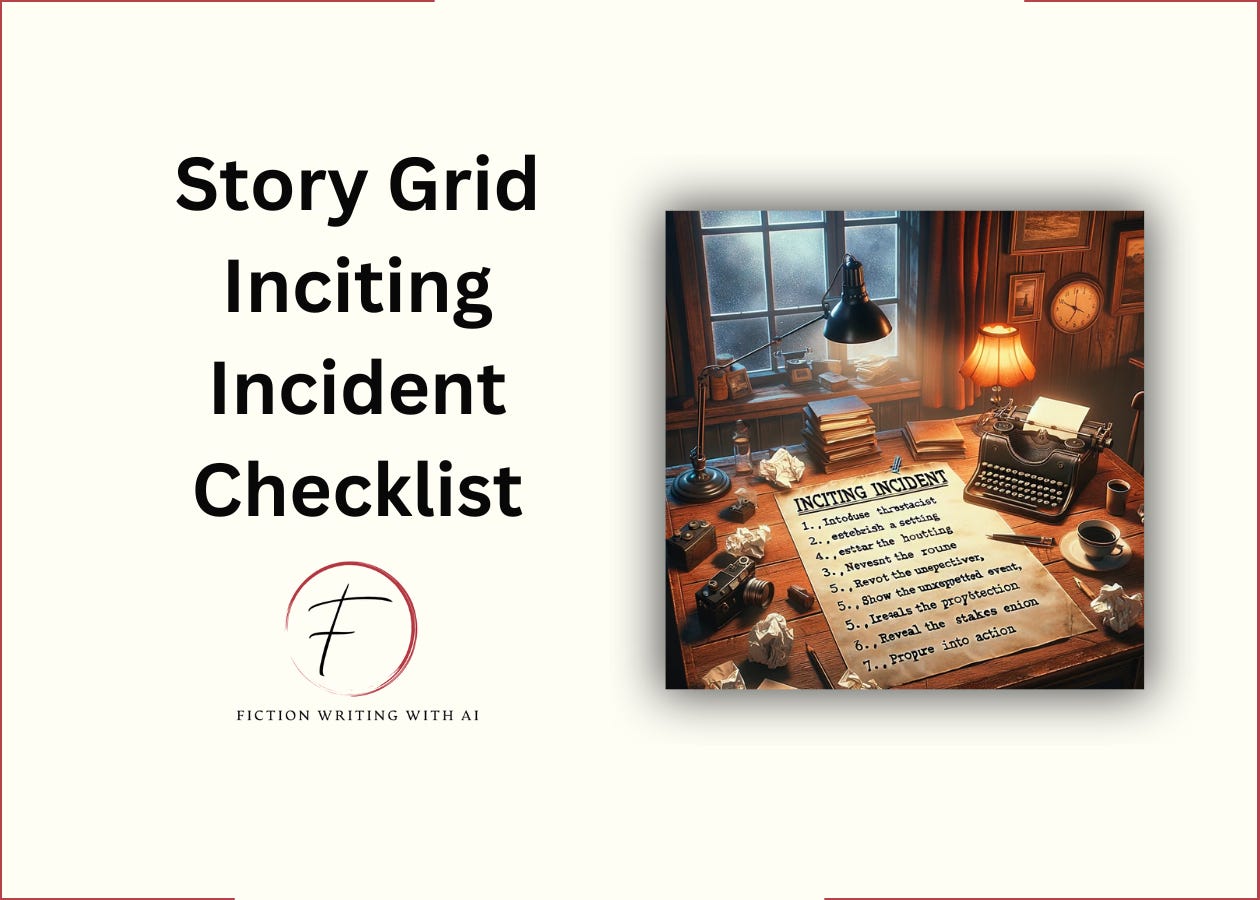Want To Write A Page-Turner? Follow This 4-Part Checklist To Craft The Perfect Inciting Incident
Hey there!
How do you hook a reader and keep them turning the pages?
A killer inciting incident.
And according Tim Grahl, StoryGrid CEO, and author of five books, including the perennial sellers Running Down a Dream and Your First 1000 Copies—it’s a lot harder than it seems.
So, today we’re breaking down Tim’s four-step checklist for creating an exciting beginning for your story and then we will teach AI to do it for you…so it’s not so hard.
The Inciting Incident
The inciting incident is the event that sets the story in motion and introduces the central conflict.
It creates a point of no return for the protagonist, where they cannot go back to their previous life. This moment usually occurs early, within the first 10-15 percent of the book. It matters because it establishes the stakes, urgency, and central conflict that will drive the rest of the plot.
It can be a bad thing; aliens invade.
Or it can be a good thing, like Harry Potter’s acceptance into Hogwarts.
Either way, something happens, life changes, and the protagonist is forced into action, which sets the rest of the story in motion.
The 2 Types Of Inciting Incidents
There are two types of inciting incidents.
Coincidental
Choice
For example, a character might choose to move across the country for a new job, setting off the chain of events in the plot. This is choice. On the other hand, an external event like a natural disaster, sudden illness, or the action by the antagonist can create an unexpected disruption to life as “normal.”
The important point here is you need to be clear whether it’s an action taken by a character or a coincidental/external event so the reader knows what’s starting the story.
Now, let’s take a look at the checklist.
How To Create The Perfect Inciting Incident: 4-Part Checklist
These are the rules for you inciting incident
1. Align With Genre Expectations
Before you can craft a killer inciting incident, you must understand what readers expect from your chosen genre.
For example, in a crime thriller, readers expect the discovery of a body or crime scene to set events into motion. With romance, they're looking for a love connection. And in fantasy, the reader is looking for magic.
Study your genre's tropes, then align your inciting incident with those expectations.
2. Disrupt The Protagonist's World
With your genre promise fulfilled, now it's time to yank the rug out from under your protagonist's feet and set them on an all-new, high-stakes path.
For example:
Tragedy: The cancer diagnosis in the Fault In Our Stars.
Loss: The cyclone destroying Dorothy's home in the Wizard of Oz.
Opportunity: New romance, power, or a new career like Mitch getting the dream job in The Firm.
Whatever it is, it needs to create imbalance in the protagonist's previous way of life.
Part 3: Keep Readers Guessing
The real page-turning magic comes from the mystery your create around the inciting incident itself.
For the protagonist, there’s more than meets the eye. What do they have no idea about yet? What do they not see or understand? For example, in The Firm, Mitch has no idea that the partners of the Memphis law firm Bendini, Lambert & Locke are deep into organized crime.
When you hold back some the cards, you provoke the readers' curiosity.
Part 4: Foreshadow The End
While your inciting incident jerks the story into high gear, it should also hint at the end—without giving it away.
When the reader gets to the end they should be surprised but they should also realize the story had to end this way given the inciting incident.
Continuing with our example from The Firm, while Mitch lands the dream job, the excessive security measures plant an early seed that his job might be too good to be true. Early warnings, like invasive monitoring and the firm's control over its employees' lives, serve as red flags that Mitch's dream job might actually be a facade for illegal activities. As the story unfolds, these initial signs of trouble are validated, leading to a climax that ties back to the inciting incident, making the story's end anticipated and satisfying.
And that’s your checklist for creating the perfect inciting incident.
Align with genre conventions
Disrupt the protagonist’s life
Keep the protagonist (and the reader) guessing
Point to the end
Follow this checklist and readers will say, "I just couldn't put it down!"
Let’s give this a try AI.
Draft An Inciting Incident With AI
This prompt builds an inciting incident using the 4-part checklist from above.
To begin, open a new chat session. Then, add your Sub-Genre, Plot Archetype, and Outline to the below prompt. Paste the prompt into the chat window and hit enter.
I used Google’s Gemini, but this prompt will work with Claude or ChatGPT.
Today, we'll use this logline for our example: "A former competitive gamer and ambitious copywriter quits his job after an injury ends his NHL dreams. He starts a ghostwriting agency, facing entrepreneurship challenges, ethical issues, and personal growth. He learns true success combines passion, impact, and personal fulfillment."
Here’s the prompt:
Keep reading with a 7-day free trial
Subscribe to Fiction Writing With AI to keep reading this post and get 7 days of free access to the full post archives.




